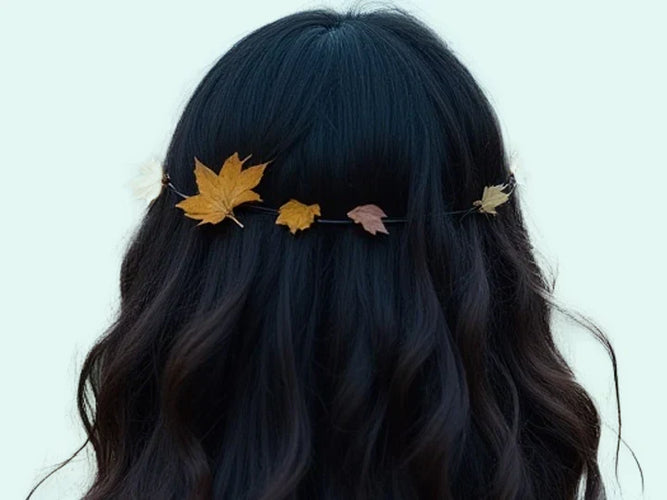Do you notice more hairs on your pillow or in the shower drain during autumn? Don’t worry, you’re not the only one. Many people experience seasonal hair loss or autumn hair shedding, which is a temporary increase in hair fall. In this blog, you’ll discover why it happens, how long it usually lasts and, most importantly, what you can do to keep your hair healthy and strong.
What is seasonal hair loss?
Seasonal hair loss is a temporary condition that mainly happens in autumn. During this period, more hairs than usual are in the shedding phase of the hair growth cycle. This can make your hair fall out a bit faster. It is a natural process that usually recovers on its own. The cause lies in the natural hair growth cycle: our hair grows, rests and eventually falls out in a fixed rhythm. In summer, sunlight helps us keep more hairs in the growth phase. Once autumn begins, this rhythm shifts, and many hairs enter the resting and shedding phases (the telogen and exogen phases) at the same time. The result? Noticeable, but temporary, autumn hair shedding.
It is important to know that this type of hair loss recovers on its own within a few weeks to months. It is not a sign of permanent damage. Women are especially sensitive to this phenomenon, and worldwide, more people report hair loss between late August and November.
UV damage to your hair
Did you enjoy a lot of sun on your head during summer? Sunlight may seem good for your hair, but too much UV radiation can damage the hair follicles. This effect often becomes visible later. You guessed it: usually in autumn.
Is hair loss in autumn normal, or should you be worried?
It is normal to lose between 50 and 100 hairs a day. In autumn, this number can temporarily rise to around 150 hairs per day. So, there is usually no need to panic. However, there are some warning signs that may point to an underlying problem:
- Hair loss lasting longer than 12 weeks
- Noticeable thinning patches
- Itching, redness or inflammation on the scalp
If you notice any of these symptoms, we recommend consulting a general practitioner or dermatologist.
Tips: how to support your hair during autumn
1. Nourish your hair from within
What you eat shows in your hair. In autumn, your body needs extra nutrients that also support hair growth. Think of vitamin D, iron and zinc. A shortage of these three nutrients may lead to diffuse hair loss or weakened hair roots. You can get them through food or choose a quality supplement such as the Neofollics Hair Growth Supporting Tablets. These are specially developed to strengthen the hair root from the inside out.
Would you like to learn more? Read our article about the best nutrients for hair growth or about vitamin D.
2. Take care of your scalp
Did you know your scalp is the foundation for healthy hair? In autumn, the air becomes drier and heating indoors makes it worse. Your scalp may become irritated, dry or flaky, which directly affects the quality of your hair growth.
Our tip? Cleanse your scalp with a gentle, sulphate-free shampoo such as the Neofollics Scalp Therapy Exfoliating Shampoo. Or treat your scalp once a week with an extra nourishing treatment, for example the Neofollics Scalp Therapy Nourishing Hair Mask. You can also try massaging your scalp gently for a few minutes every day. This helps stimulate blood circulation and may activate dormant hair follicles.
Want to know more? Check our article about how to recognise and treat a dry scalp.
3. Relax and take it easy
Stress is an underestimated factor in hair loss. It can cause a hormonal imbalance and disrupt the hair growth cycle, leading to telogen effluvium (sudden hair shedding). Try to keep stress levels under control by getting enough sleep, exercising and adding relaxing routines to your day.
Also, physical stress on your hair, such as tying it too tightly, using a lot of heat or chemical treatments, makes it more fragile. In autumn, when your hair is already in a sensitive phase, it is extra important to limit styling. If you still want to style your hair, always use a heat protector and set your tool to the lowest temperature possible.
4. Use targeted products
Not all hair products are the same. During autumn, you can benefit from care products that are specially designed to stimulate hair growth and strengthen the hair root. Think of serums or shampoos with ingredients like caffeine, biotin, niacinamide and natural DHT blockers such as saw palmetto. Neofollics offers a complete range of scientifically backed hair care that has proven effectiveness against hair loss. Discover which products fit your situation best.
Do you have autumn hair loss?

Frequently Asked Questions
How long does autumn hair loss last?
Usually 6 to 8 weeks, after which it stabilises.
Is it normal to suddenly lose a lot of hair?
Yes, as long as it is temporary and without bald patches. If it continues for more than 12 weeks, contact your general practitioner.
Can I do something about it?
You can limit the impact with the right nutrition, scalp care and suitable products.
Are there medical causes?
Yes, if the hair loss is long-lasting or severe, another condition may be involved. Have this assessed by a general practitioner or dermatologist.
Conclusion
Seasonal hair loss in autumn is a completely normal phenomenon, but that does not mean you have to watch helplessly. This is the time to take preventive steps and support recovery. How? Focus on your nutrition, care for your scalp with extra attention and reduce stress. This way, you give your hair the best chance to stay strong and healthy. Small changes in your daily routine can already make a big difference.
Would you like to better understand your personal situation or find tailored support? Read the Neofollics articles on hair loss and discover which solutions fit your hair type. Whether you are looking for a gentle shampoo, a supplement or a complete step-by-step plan – there is always a solution for you.
Sources
Kunz et al. (2009) – Seasonal shedding of human hair: Analysis of over 800 subjects
This information does not replace professional medical advice. If in doubt, always consult a doctor or specialist.













